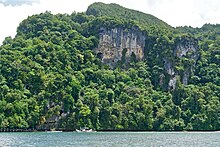
Back كهوف تابون Arabic كهوف تابون ARZ Tabon-Höhlen German Cuevas de Tabon Spanish Grotte de Tabon French Gua Tabon ID 타본 동굴 Korean Tabongrotten Dutch Tabongrottorna Swedish Kuwebang Tabon Tagalog
Mga Yungib ng Tabon | |
 | |
| Alternative name | Tabon Cave Complex |
|---|---|
| Location | Quezon, Palawan, Philippines |
| Coordinates | 9°16′48″N 117°58′53″E / 9.279882°N 117.9814°E |
| Management | National Museum of the Philippines |
The Tabon Caves is a cave system located in Lipuun Point, Panitian, Quezon, Palawan in the Philippines. Dubbed as the country's "cradle of civilization",[1] it is a site of archaeological importance due to the number of jar burials and prehistoric human remains found starting from the 1960s, most notably the Tabon Man.[2] The system is a part of the Lipuun Point Reservation, which has been protected by the Philippine government as a museum reservation to protect the caves and its immediate vicinity from deforestation and to preserve the cultural artifacts present there.[3]
The caves are named after the Tabon scrubfowl. It is bordered on the south by the town proper of Quezon, Panitian on the west, and the South China Sea on the north and east. Out of 215 known caves, 29 have been fully explored, with seven of them publicly accessible. Other excavated, unexamined remains are stored onsite. In 2006, the site, collectively named as Tabon Cave Complex and all of Lipuun, was added to the tentative list of the Philippines for future UNESCO World Heritage Site nomination.
The complex is managed by the National Museum of the Philippines[4] and was declared as a National Cultural Treasure by the same institution in February 2011.[1][2][5]
- ^ a b Mendoza, Victoria Asuncion (August 7, 2012). "Tabon Cave in Palawan declared Nat'l Cultural Treasure". Philippine Information Agency. Retrieved September 2, 2014.
- ^ a b "Philippine Caves Declared National Cultural Treasure". Caving News. August 8, 2012. Retrieved September 4, 2014.
- ^ "Tabon Cave Complex". National Museum. Retrieved February 9, 2016.
- ^ "Tabon Caves: Site of an important Philippine archaeological discovery". Palawan Council for Sustainable Development. Retrieved February 1, 2009.
- ^ "Tabon Cave in Palawan: A national treasure". August 15, 2014. Retrieved September 4, 2014.
